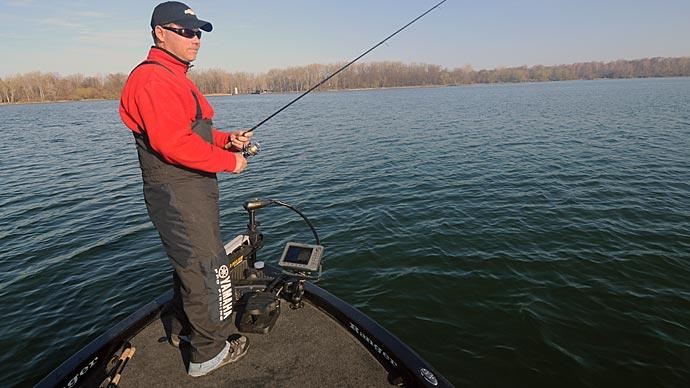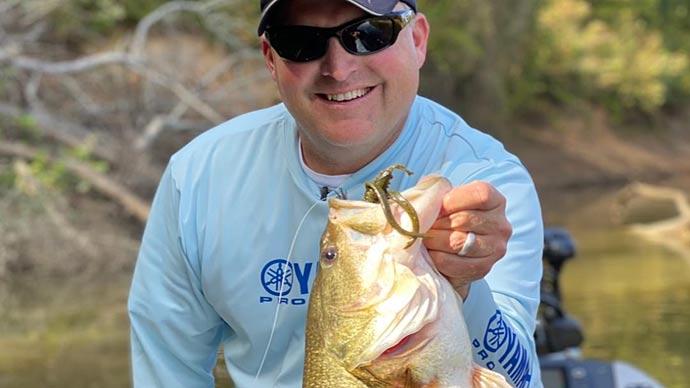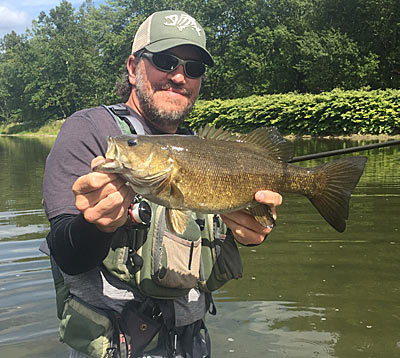
Pete Cartwright’s experience with western Pennsylvania’s smallmouth rivers runs deep. He spends plenty of time on the Youghiogheny, his guiding business’s namesake. And he has fished the Allegheny since he was a teen when a friend invited him to his camp at the mouth of the tributary Kiskiminetas River near Freeport.
Cartwright’s relationship with the Allegheny blossomed a few years later. “I started fishing it when I was 16, and I’m 47 now,” he said. “That’s a long time.” Today he leaves his home in White Oak, not far from the river’s end in Pittsburgh, and heads north, toward its headwaters when it’s time to fish with friends or clients. “It’s a free-flowing river from just above East Brady up to Warren,” he said of the more than 125-mile stretch. Below that, the river is controlled by locks and dams. “Fishing is excellent.”
While some anglers target the Allegheny’s walleyes and muskies, most fish for its smallmouth bass. There are plenty to catch, including big ones. Cartwright said day trips in April average 30 fish with at least one measuring 19 inches — about 3 1/2 pounds — or longer. “In spring, if you can get on them, you catch a lot,” he said. When summer’s heat and lower water levels arrive, numbers drop some — his daily average is 20 — but the big ones keep coming through fall and winter. His largest measured 23 1/2 inches.
Despite year-round fishing that’s equally productive from boat or waders, the Allegheny River isn’t top of mind for many anglers outside its watershed, overshadowed by the Susquehanna, Pennsylvania’s well-known smallmouth river to the east. But that doesn’t mean you shouldn’t get to know it. You’ll find plenty to like, starting with the solitude of its surrounding scenery.
Access is plentiful
The Allegheny River is navigable water, so Cartwright regularly sees jet boats, canoes, and kayaks on its water. But he walks right in. “That’s all I do is wade,” he said. “You can wade most of it.”
Reaching the water isn’t difficult. The river’s northern stretch flows within the Allegheny National Forest. Cartwright said there are boat ramps and roadside pull-offs along its entire free-flowing stretch, a good portion of which is paralleled by U.S. 62 and PA 268.
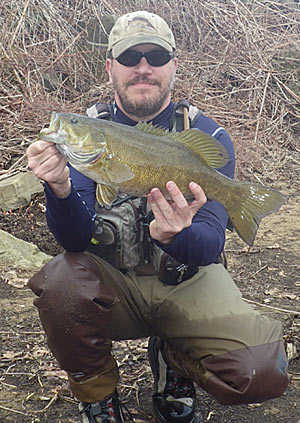
The construction of waterside bike trails, including 6-mile the Samuel Justus Recreation Trail and 30-mile Allegheny River Trail, which take you between Oil City and Parker, have helped the most. “I use that a lot for access,” said Cartwright, who rides a mountain bike, strapping gear to a rack over its rear wheel. “I’ll take my bike, pedal up the trail 3 or 4 miles, and fish a spot.” While he might have to bush-whack a bit to the river from the paved trail, it’s the quickest way to spots once only reachable by watercraft.
But access is only half the battle. The river has to be fishable, too. So, before Cartwright heads out, he checks U.S. Geological Survey gauges online. Placed along the river’s length, each monitors water height and flow. While he reviews both, height usually decides where and how he’ll fish. Most gauges read between 3 and 4 feet during summer. “In Franklin, if it’s under 4 feet, you can wade,” he said.
As the Allegheny’s height rises, Cartwright said access changes. It’s wadable up to 5 feet, he said, as long as you exercise caution. And it remains floatable up to 6 feet. But above that is dangerous. He sees the highest water — as much as 10 feet or more on the gauges — most often in spring and late fall. And while that pauses his wading, he keeps fishing by walking the bank.
When Cartwright can get into the water, he wears waders and boots sporting screw-in metal studs after its temperature falls to 70 degrees, which usually happens as September ends. Once it warms to that point in the spring, he wet wades — shorts, heavy socks, and wading boots — until fall.
The best spots
Cartwright’s smallmouth fishing focuses on a specific piece of structure that’s common along the Allegheny’s length. “They love islands,” he said. But even more important than structure is current. While the amount of water entering the river, whether from rain, snow melt, or releases at Kinzua Dam in Warren, which creates the 7,647-acre Allegheny Reservoir, affects the current in the short term, the gradient of the river’s rocky bed dictates it daily.
Cartwright prefers stretches whose elevation drops about 2 feet over a half-mile, which is typical for much of the river. “[Smallmouth] want to find the best current to feed,” he said. “They want current that’s slower than what’s around them.”
Cartwright has two favorite sections, each about 25 miles long. He fishes from Tionesta, where he owned a camp for about a dozen years, downstream to Franklin most of the time. And the stretch from Parker upstream to Franklin is a close second. “There’s not a bad stretch,” he said. “You can find fish through that whole [free-flowing] section, trophy fish, too.”
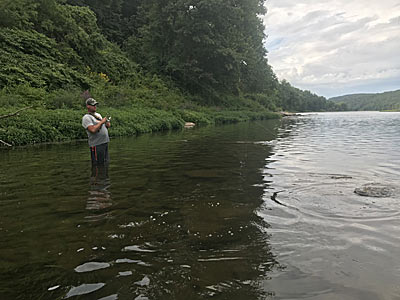
Most of the year, Cartwright rarely considers depth while fishing. “I’ve caught big smallmouth in ankle deep water,” he said. The exception comes in winter when smallmouth gather in deep stretches of the main river with the slowest current as water level drops and tributaries freeze. But even then, a warm sunny day will pull them into waist-deep water that’s nearby.
The winter bite starts in December when Cartwright catches his biggest Allegheny smallmouth. It’s possible to catch 20 or more smallmouth from wintering holes, which might produce only a bite or two in summer. He chooses his days in January, preferring when the river runs low. “In February, I’m back on them,” he said.
As spring arrives, staying with these schools is essential as they migrate to summer locations is critical. “That’s when you have your good days,” he said. While you might catch ten over a half-day trip dealing with resident fish, he said fishing a school will double your catch rate.
In October, Cartwright said Allegheny smallmouth begin returning to their wintering holes, some traveling long distances. Moving fish, dying aquatic vegetation, and floating leaves constantly foul your line making fishing frustrating. He said it isn’t much better on many November days when Allegheny Reservoir is pulled down and autumn rains fall, raising the river’s height.
Rigging up
Allegheny River smallmouth eats the same lures as those swimming elsewhere. Cartwright said when they chase baitfish, topwaters, such as a Whopper Plopper, or shallow-diving crankbaits, such as a Big O, catch plenty. But day in and out, he relies on soft-plastic lures. “My main bait is a tube,” he said. And chances are almost sure it’ll be in some version of green pumpkin.
Cartwright will occasionally fish an oddball color, attempting to jumpstart a bite or uncover an advantage. “But I don’t have a second favorite,” he said. He rotates among several flake colors in his tubes, which usually are 412 Bait Co.’s 3.5-inch 412ubes. “At times, flake color will make a difference,” he said. Many days it's black, but purple and gold are good, too. And copper flake is prominent in Smallies On The Yough Pumpkin, a color he co-created with 412 Bait Co.
Cartwright rigs his tubes with an internal lead head. Most weigh 1/8 ounce, but he will drop to 1/16 ounce for slow water or tough bites and step up to 3/16 ounce to overcome high or deep water.
See some action for other finesse soft plastics, such as small worms, which Cartwright rigs wacky or Texas style. And he’ll fish a 412 Bait Co. 3.5-inch grub, which sports a big tail, on an 1/8-ounce lead head in spring and fall when the water is dirty. “You can still catch them, but you need something that makes a lot of noise,” he said. His color selection is the same for these baits, with the addition of solid black or white grubs.
Soft-plastic offerings have to do one thing well — imitate a crawfish. They are everywhere in the Allegheny, making them an easy and regular meal for its smallmouth. “Most of the time, I like to play the odds in fishing,” Cartwright said. “It never has done me wrong.” Smallmouth choose his tube even during mayfly hatches when millions of easy-to-eat bugs float on the surface.
Cartwright casts all these lures on a spinning combo — a 7-foot, 4-inch G Loomis sporting a medium action and 2500 Shimano Stradic Ci4 reel. It casts light, lures long distances, and provides the leverage he needs to move big smallmouth through current while wading. “They are quite hardy in that river,” he said. “They fight hard.”
Cartwright spools his reel with 8-pound test Edge fluorocarbon, which is made by Gamma, whose headquarters is in Oil City, not far off the Allegheny’s banks. In winter, he switches to 6-pound test when fishing 1/16-ounce hair jigs, which he ties himself.
While Cartwright brings a spare spool filled with braided line when he plans to fish topwaters — fluorocarbon sinks, making that difficult — he believes the super line slows anglers, especially when they feel they need a leader. When you break off, that requires tying twice the knots, compared to straight fluorocarbon. “And if you’re jigging in rocks, you’re going to get snagged,” he said. Not dealing with leaders also means a lighter load. “The less equipment you have, the better when you are wading,” he said.
Cartwright stashes his gear, including a scale, first-aid kit, and up to three bottles of water, inside an L.L. Bean Rapid River Vest Pack. It features fly-vest style pockets on the front and packs on the back. He can strap a travel rod to it, too. But he isn’t limited to what he can carry. He also stashes tackle boxes in his vehicle, giving him the chance to make last-second selections when he sees the river’s condition firsthand. And when he fishes with friends, each carries different lures, sharing them with the group.
One thing you’ll want plenty of when fishing the Allegheny River is extra time for exploring, starting with Allegheny National Forest, which offers camping and miles of trails for hiking, mountain biking, and riding ATVs. In nearby Titusville, ride an excursion train and visit a museum that marks the spot where Col. Edwin Drake sunk the world’s first oil well, making the region the birthplace of the modern petroleum industry. And there is shopping, lodging, and restaurants in Oil City and Franklin.
Learn more about fishing the Allegheny River at Cartwright’s website, smalliesontheyough.com. Research accommodations and more activities at these websites: visitanf.com, forestcounty.com, or oilregion.org.
BassResource may receive a portion of revenues if you make a purchase using a link above.


